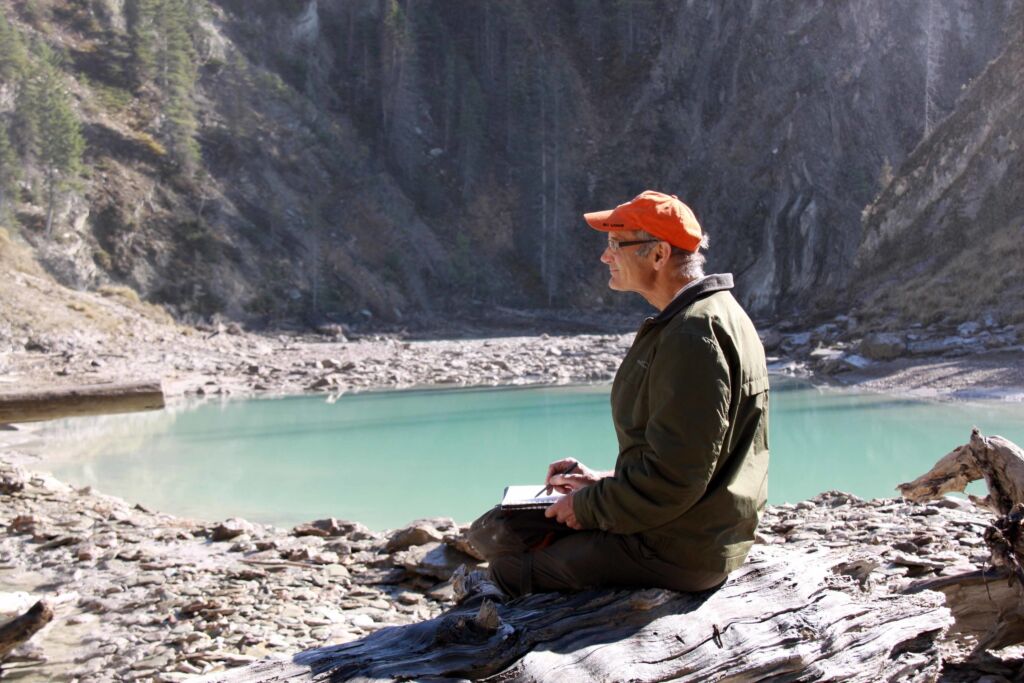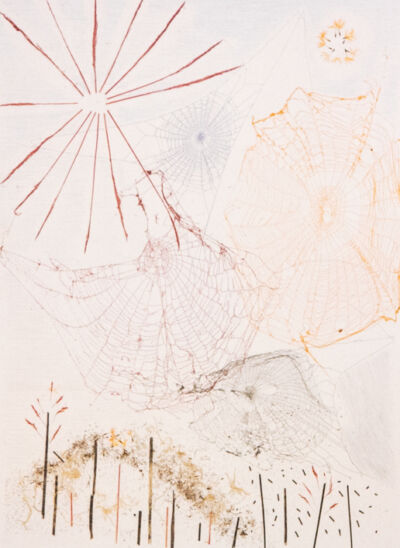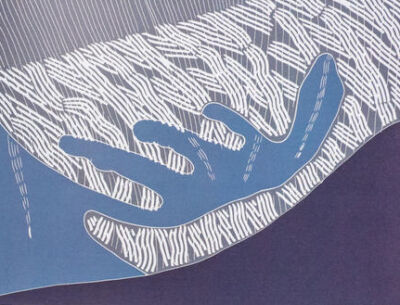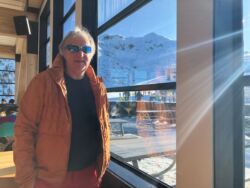‘Nuanced mountain and landscape life’
Alpine Anatomy: The Mountain Art of Arnold Shives
Bill Jeffries, Darrin Martens, and Glenn Woodsworth (eds.)
Vancouver: Simon Fraser University, Burnaby Art Gallery, and Tricouni Press, 2012
$39.95 / 9780981153612
Reviewed by Ron Dart
*

There are different approaches to painting when an artist turns to nature. There is the detailed and almost photographic realism of Robert Bateman. There is the symbolic approach to nature that we often find in First Nations and other painters influenced by Jung’s mythic tradition and ethos. Then, there are those such as the Group of Seven and Emily Carr, who in their diverse and wide-ranging artistic ways, synthesize creative approaches to depicting nature. Such is Alpine Anatomy: The Mountain Art of Arnold Shives as it ably depicts, in text and diverse paintings, why this is the case.
There can be no doubt Arnold Shives is one of Canada’s finest painters and the fact he has spent much of his life in Vancouver and many a year in the BC mountains means mountaineering and painting wed in a unique way in Shives’s sensitive approaches to reading the anatomy of the alpine ethos. But, before discussing Shives’s paintings, it is appropriate to mention the varied essays that are woven together in the finely crafted tapestry of the book.

The reflections by Glenn Woodsworth (“Endless Mountains and Valleys: The Art of Arnold Shives”), Toni Onley (“In the Mountains with Arnold”), Edward Lucie-Smith (“Shives the Transcendentalist”), Bill Jeffries (“From Schelling to Michelet and Cezanne to Shives”), Darrin J. Martens (“Elements of an Art Practice: The Linocuts of Arnold Shives”) and John Grande’s (“An Interview with Arnold Shives”) make for a superb high peak and long ridge overview of Shives’s artistic vision and vocation. Each of these essays are worthy of multiple meditative reads.

Alpine Anatomy begins with Shives roped up on the “True Summit of Black Tusk” in 1961 followed by two paintings, “Fall Reflections” (1980) and “Spire Dance” (2007). There is then another photograph of Shives, frost on his bearded head, after a winter ascent of Monarch Mountain in 1964. A few more photographs follow of Shives in the, predictably and naturally so, mountains of his artistic journey. The rest of the book highlights painting and linocuts in a chronological order from “Bare Trees and Mountain” (1961), “Seven Sisters Range and Cabin” (1962), “Malcolm Lowry’s Dollarton, North Vancouver (1989), “Homage to bp” (1995), bpNichol, (1944-1988) a friend of Shives’s (a fine correspondence took place between them), and the final painting, “Homage to Riopelle XX” (2010). Jean-Paul Riopelle (1923-2002) was a French Canadian painter whose impact on Shives is obvious. All of the paintings between 1961-2010 reflect various styles but nature, for the most part, dominates and the anatomy back of the sheer visual is probed again and again. Needless to say, mountains are the main text Shives draws from but he also turns to forests and Vancouver life in a transition phase and season.
I have been fortunate to do many a trek in the mountains with Arnold, him always with a sketch pad and, when resting, pad out and pencil at work. He and I have worked together on three books, each of them dealing with mountains, he doing the sketches, I the text: Mountaineering and the Humanities (2007), Thomas Merton and the Beats of the North Cascades (2008) and Thomas Merton and the Counterculture: A Golden String (2016). The exquisite sketches done for these three books embody and reflect Shives’s artistic range not found in Alpine Anatomy and yet each, in their diverse ways, touch lightly on the anatomy of nature, mountains and the wide range of ideas that mountains evoke and whisper forth.

Alpine Anatomy judiciously threads together Shives’s nuanced mountain and landscape life, the texts in the book fleshing and filling out Shives’s artistic journey and how such a journey is reflected in his paintings and why. This is a must-have book for those interested in the history of mountaineering on the West Coast, BC, and elsewhere, and, equally important, as a doorway into the textured cathedral and sanctuary of Shives’s creative vision when, as Blake suggests, “great things are done, when men and mountains meet.” Such is the fullness of this colourful book that speaks much about BC history at multiple levels.
*

Ron Dart has taught in the Department of Political Science, Philosophy, and Religious Studies at the University of the Fraser Valley since 1990. He was on staff with Amnesty International in the 1980s. He has published 40 books including Erasmus: Wild Bird (Create Space, 2017) and The North American High Tory Tradition (American Anglican Press, 2016). [Editor’s note: Ron Dart has recently reviewed books by Torbjørn Ekelund, Jan Zwicky, Jan Zwicky & Robert V. Moody, D.L. (Donna) Stephen, Elizabeth May, and Stephen Hui (Destination Hikes) for The British Columbia Review. He has also contributed a reflection on several aspects of mountaineering life in his Missives from the Peaks as well as four essays: Canadian mountain culture and mountaineering, From Jalna to Timber Baron: Reflections on the life of H.R. MacMillan, Roderick Haig-Brown & Al Purdy, and Save Swiss Edelweiss Village to The BC Review.]
*
The British Columbia Review
Interim Editors, 2023-24: Trevor Marc Hughes (non-fiction), Brett Josef Grubisic (fiction)
Publisher: Richard Mackie
Formerly The Ormsby Review, The British Columbia Review is an on-line book review and journal service for BC writers and readers. The Advisory Board now consists of Jean Barman, Wade Davis, Robin Fisher, Barry Gough, Hugh Johnston, Kathy Mezei, Patricia Roy, Maria Tippett, and Graeme Wynn. Provincial Government Patron (since September 2018): Creative BC. Honorary Patron: Yosef Wosk. Scholarly Patron: SFU Graduate Liberal Studies. The British Columbia Review was founded in 2016 by Richard Mackie and Alan Twigg.
“Only connect.” – E.M. Forster



2 comments on “‘Nuanced mountain and landscape life’”
A stunning review of Alpine Anatomy—Arnold Shives’s mountain art is both meditative and majestic. A must-read for nature and art lovers!

